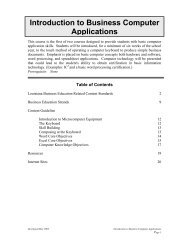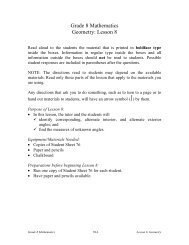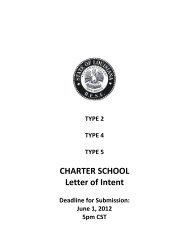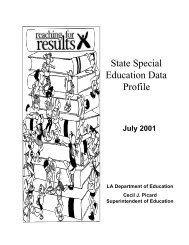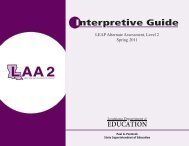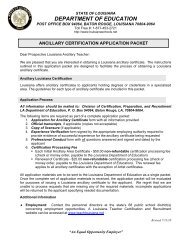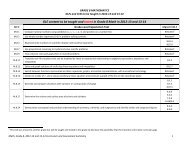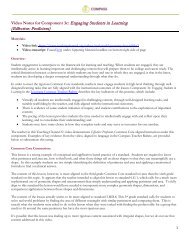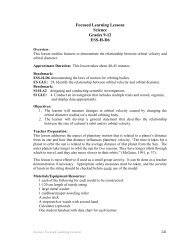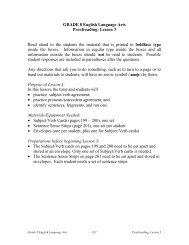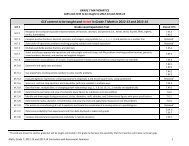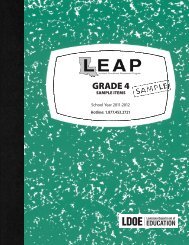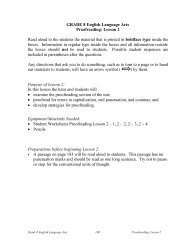School Improvement - Louisiana Department of Education
School Improvement - Louisiana Department of Education
School Improvement - Louisiana Department of Education
You also want an ePaper? Increase the reach of your titles
YUMPU automatically turns print PDFs into web optimized ePapers that Google loves.
Rubric:<br />
Acceptable<br />
Not Acceptable<br />
V. The contributing factors related to the strengths and weaknesses are based on an accurate<br />
interpretation <strong>of</strong> the data.<br />
a. All contributing<br />
factors related to the<br />
strengths and<br />
weaknesses are based<br />
on an accurate<br />
interpretation <strong>of</strong> the<br />
data.<br />
Rationale/Comments:<br />
b. At least 75% <strong>of</strong><br />
the contributing<br />
factors related to the<br />
strengths and<br />
weaknesses are based<br />
on an accurate<br />
interpretation <strong>of</strong> the<br />
data.<br />
c. Less than 75% <strong>of</strong><br />
the contributing<br />
factors related to the<br />
strengths and<br />
weaknesses are based<br />
on an accurate<br />
interpretation <strong>of</strong> the<br />
data.<br />
d. Contributing<br />
factors related to the<br />
strengths and<br />
weaknesses are not<br />
based on an accurate<br />
interpretation <strong>of</strong> the<br />
data.<br />
GOALS<br />
Guideline I. Goal(s) are directly linked to student learning. A goal <strong>of</strong> parental involvement is not a direct link.<br />
• Look at the overall clarity and presentation <strong>of</strong> the goals.<br />
• If goals are accomplished, will the school improve academically?<br />
Rubric:<br />
Acceptable<br />
Not Acceptable<br />
I. The goals are linked to student learning and clearly state the direction <strong>of</strong> school improvement.<br />
a. The goals are<br />
clearly linked to student<br />
learning and state the<br />
direction for school<br />
improvement.<br />
b. The goals are<br />
linked to student<br />
learning and state the<br />
direction for school<br />
improvement in a<br />
relatively clear manner.<br />
c. The link between<br />
the goals and student<br />
learning and school<br />
improvement is unclear<br />
or weak.<br />
d. There is no link<br />
between the goals and<br />
student learning and the<br />
directions for school<br />
improvement.<br />
Rationale/Comments:<br />
Guideline II. Goals address the weaknesses with top priority being in Academic Achievement.<br />
• The goals should be derived from data in the CRT (LEAP, GEE, and include LAA); NRT (iLEAP);<br />
Attendance and/or Dropout; Percent Pr<strong>of</strong>icient; DRA; DIBELS; Pre‐K/Kindergarten Screening tests, or<br />
other standardized teacher‐made unit assessments.<br />
• Goals should be limited to three.<br />
• Struggling schools should limit goals to one (1) or two (2).<br />
• See <strong>School</strong> <strong>Improvement</strong> Crosswalk (#9).<br />
• Exception: If the goals are stated in measurable terms, they must use accurate measures to receive a<br />
rating no higher than a ‘b”.<br />
Rubric:<br />
Acceptable<br />
Not Acceptable<br />
II. The goals accurately address the school’s NCLB weaknesses in Academic Achievement.<br />
a. All NCLB related<br />
weaknesses are clearly<br />
addressed.<br />
b. At least 75% <strong>of</strong><br />
NCLB related<br />
weaknesses are<br />
addressed.<br />
c. Less than 75%<br />
NCLB related<br />
weaknesses are<br />
addressed.<br />
d. The goals do not<br />
address the NCLB<br />
related weaknesses.<br />
Rationale/Comments:<br />
76



